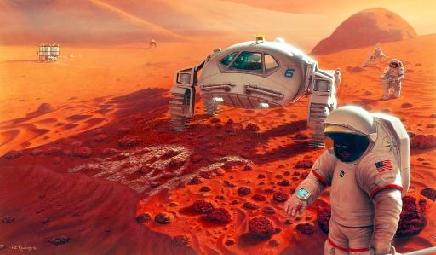) The distance between our ball and its reddish friend is expected to reach its closest in August in 50 thousand years; 56 million kilometers will separate the two

Tuesday, July 15, 2003 0:00 am by:
If the Martians want to attack the Earth - the next few months are the best time for it. The red star will reach during this period the closest point in 50 thousand years to our sphere. During the month of August, Mars, the Earth and the Sun will line up, an event that occurs once in many years.
Mars and the Earth come closer to each other every few years, depending on their position in the rotation around the Sun. The Earth's orbit around the Sun is very short, compared to its red friend. August 27 will bring with it enormous excitement for astronomers and other stargazing enthusiasts: on this day, the distance between Earth and Mars will be only 56 million kilometers, compared to the usual 96 million kilometers. David Eicher, editor of the American space magazine "Astronomy", told "USA Today" that the spectacle is going to be spectacular. "Without a doubt this will leave the amateur astronomer community in the market," he said.
Advertisement The reason for the proximity of the two stars lies in the shape of their elliptical orbits around the sun. During the coming months, the Earth will move in its furthest orbit from the Sun, while Mars will move in its closest orbit to the Sun. The fact that the movement of Mars and the Earth occurs at the same time is what makes them reach the closest point.
Eicher also said that the best time to observe Mars is precisely in July, because during the next month the dust storms on Mars may make the observation difficult. In mid-July, Mars rises in the constellation of Aquarius. The star should show very bright and will appear 2.5% the size of the moon.
Direct link to this page: https://www.hayadan.org.il/mars020103.html
Mars is approaching, the manned landing on it is moving away
2/1/2003
As Mars approaches Earth, when the two will reach their closest point since prehistoric times in late August 2003, the manned landing on its surface is again moving away. The reason: the economic crisis currently affecting many countries in the world, led by the USA.
The BBC reports that it was a bad year for the space business. Far fewer satellites have been launched this year than initially expected and manufacturers have had to cut jobs. This year again doubt arose as to the continuation of manned flights into space.
As in the last thirty years, this year too no astronaut took off beyond the coffee orbit at an altitude of -500 km around the Earth.
Meanwhile, NASA sees the International Space Station as a stepping stone to space - both for scientific needs and for business needs.
At the Kennedy Space Center in Florida, the shuttle flights grabbed headlines as the launches did in the 2006s. After the Apollo program, the shuttles were supposed to lower the cost of space flight. This did not happen and therefore NASA is looking for replacements for the shuttle. At Rocketdyne of Canoga, California, which specializes in rocket engines, project manager John Villaja hopes to achieve initial results in XNUMX. "We are working on developing engines for rockets with only two stages," he says.
The technology needed to build a single-stage missile would require more investment than the agency can afford at this time. The first priority is of course to develop a reliable and cheap approach to space.
NASA wants to cut the costs of sending a man into space to a tenth of the current price. If you can achieve this, it will open up the space for business.
Retired astronaut Story McGrave questions whether Microsoft will be able to deliver the goods. "The amount of money that will be invested is not the problem, but what to do with the new measures," he said.
The number one priority is to lower the cost. We knew how to do business in the sixties of the 20th century, and today we don't know how to do it," he added.
Even so, many in the space industry should now set their sights on Mars. Daniel LeBlanc, director of operations in the visitor area at the Kennedy Space Center sees his job as getting people excited about the "last frontier". Those of us who lived and breathed the space program like me, and hope that one day we will reach Mars, this is like a mission that God inspires." said.
In Russia, scientists are already discussing the possibility of flying six people to Mars in 2015 at the earliest. Sergey Gorbunov, spokesman for the Russian space agency Russia Cosmos, believes that people will always look for ways to reach new worlds.
He believes that international cooperation is necessary, because billions of dollars are needed for such a task. However, to make it worthwhile, each journey should be more than planting flags and leaving footprints - something more than a quick visit. Tim Furniss of Plate International doubts the practicality of such a long flight. "We don't yet have the technology to support a human crew for a nine-month stay on Mars," he said.
Another problem is that NASA still needs to confirm that it is exploring Mars in a realistic way," he added.
Given the cost, a human journey to Mars is now a long way off. The astronauts will have to continue orbiting the Earth only. The planets will have to wait.
